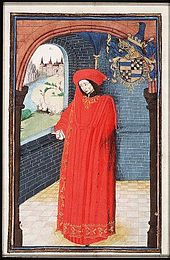Philippe Pot
Philippe Pot (* 1428 in La Rochepot , France, † September 16, 1493 in Dijon ) was a high Burgundian and French court official.
Life
Philippe was the son of Jacques Pot and grandson of Régnier Pot , the chamberlain of Philip the Bold (see Pot (noble family) ). His godfather was the Burgundian Duke Philip the Good , at whose court he made a career and who accepted him in 1463 in the knightly order of the Golden Fleece . He accumulated honors and offices, was ambassador to London and was appointed great court master in 1473 .
Philippe Pot also served as Philip's successor, Charles the Bold , before becoming King Louis XI. approached from France. When Karl died and the line of the dukes of Burgundy was ended, he switched to King Louis XI. from France across. This appointed Philippe on September 21, 1477 Grand Seneschal (Governor General) of Burgundy and accepted him into the Ordre de Saint-Michel . Because of his move to the French court, he was excluded from the Order of the Golden Fleece in 1481.
At the end of the 1470s, Pot had the Châteauneuf-en-Auxois castle , which Philip the Good had given him in 1457, rebuilt.
King Charles VIII , the successor of Louis XI, gave him the Logis du Roi at Dijon and accepted him into the royal council. Philippe Pot died in September 1493.
Tomb
Philippe Pot is best known for his tomb, which is in the Louvre in Paris. He had it prepared himself between 1477 and 1483 during his lifetime. The tomb was originally located in the chapel of John the Baptist in the abbey church of Cîteaux . After the destruction of the church by the French Revolution , it became private property before it was finally bought by the French state in 1886.
The reclining figure of the deceased lies on a grave slab with a three-line inscription, which is carried by eight mourners. Due to the lack of a tumba , the tomb has a very lively impression and is reminiscent of Burgundian funeral processions in which the corpse is carried to the grave. It falls out of the usual tomb depictions of the 15th century and is unique in this composition.
The tomb was particularly well received in the 19th century by painters who woven the tomb into idyllic scenes ( Charles Édouard de Beaumont , Alfred Stevens ), and by Auguste Rodin , his citizens of Calais , who was inspired by the ground-level installation of the almost life-size figures also to be shown without a base.
Web links
literature
- Raphael de Smedt (ed.): Les chevaliers de l'ordre de la Toison d'or au XVe siècle. Notices bio-bibliographiques. (Kieler Werkstücke, D 3) 2nd, improved edition, Verlag Peter Lang, Frankfurt 2000, ISBN 3-631-36017-7 , pp. 146-148.
- Lucien Guillemaut: Armoiries et Familles Nobles de la Bresse Louhannaise . Imprimerie Vve. Louis Romand, Louhans 1909, p. 166-168 ( gallica.bnf.fr ).
| personal data | |
|---|---|
| SURNAME | Pot, Philippe |
| BRIEF DESCRIPTION | Burgundian and French court officials |
| DATE OF BIRTH | 1428 |
| PLACE OF BIRTH | La Rochepot , France |
| DATE OF DEATH | September 16, 1493 |
| Place of death | Dijon |


